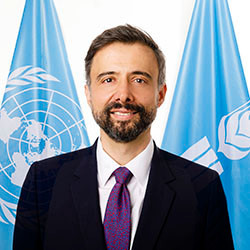International development co-operation in the face of climate change challenges, COP27
IFAD Asset Request Portlet
Asset Publisher
International development co-operation in the face of climate change challenges, COP27
By Alvaro Lario
We are meeting at COP27 at a time of multiple global crises.
I am deeply concerned about the sharp increase in hunger, malnutrition and poverty.
Last year alone, the number increased by 150 million people.
The global spike in food, fuel, and fertilizer prices is an existential threat to the world’s poor rural people. And they are the least equipped to face these shocks.
Drought and flood are wreaking havoc with crops and harvests. Rural communities are being hit by a loss of spending power.
Eighty per cent of the world’s poorest people, and most of the hungry, live in the rural areas of developing countries. Most depend on small-scale agriculture for their food and income.
I am here to advocate on behalf of these people, as they are among the hardest hit by the impacts of climate change, and also most crucial for our food security in the face of recurring crisis. But their voices are rarely heard.
Here, at COP27, we have an opportunity to change course. We have the opportunity to link our international agenda for development with our agenda for climate action. We have the opportunity to mainstream climate objectives into how we tackle the challenges of food security and poverty. This is the only way to build resilience for the future.
But to do this, we must go beyond rhetoric and take prompt action. This takes investments. Financing. Real commitments that take the bigger picture into account.
Acting on climate requires investments in food systems that fuel local production and create a world that is fair, prosperous, and peaceful—because food security and political security are closely connected. A hungry world is a desperate and unstable one.
Sustainable, climate resilient food systems need small farms. And they need farmers to be fairly and decently compensated for the food they grow, and their environmental benefits.
Small farms tend to be very efficient. They produce one third of our food on only 11 per cent of the agricultural land. In contrast, big industrial farms contribute only 18 per cent of food calories on more than half the world’s farmland.
Small farms also have a lighter ecosystem footprint, and not a major source of greenhouse gas emissions. They preserve biodiversity, and are home to a wide range of plants, insects, and pollinators. Without pollinators, humanity would not survive on our planet[1].
So how do we get finance to these small farms, where it is needed?
According to recent estimates, it will cost an extra $300 to $400 billion a year to transition to sustainable, equitable and resilient food systems.
It sounds like a huge figure. But it is less than 0.5% of global GDP. It is much less than annual agricultural subsidies. And it is a fraction of the market value of the world’s food systems, which is estimated at $10 trillion.
We also know that the US$600 billion in public finance for agriculture and fishieries mostly excludes poor rural people, and actually contributes to the over-use of natural resources.
We need to change that.
Also, at a time when financing is getting tighter, and bond markets are closed to many countries, those countries that can borrow must do so at unsustainable rates. Development partners must make sure international financing instruments are fit for purpose.
Building on its AA+ credit rating, IFAD is mobilizing funds through private borrowing and connecting with global capital markets, as well as from more traditional sources.
Our flagship Adaptation for Smallholder Agriculture Programme (ASAP), has already provided funding for adaptation to more than 6 million smallholder farmers across 41 countries.
In a new phase, ASAP+ will specifically target food insecurity, aims to mobilize US$500 million to reach some 10 million people.
We are becoming the partner of choice for assembling finance for rural areas – to achieve our climate aims and to build food security in the future. But we can’t do it alone.
Never has there been a greater need to act together.
Our cooperation and our commitments are key.
Let’s learn from the lessons of 2022.
What we need is less talk and more action. Time is running out.
